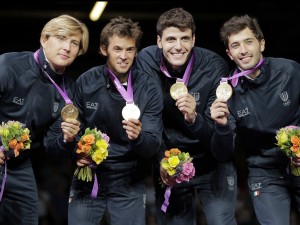
From left to right, Valerio Aspromonte, Andrea Baldini, Andrea Cassara, and Giorgio Avola of Italy are awarded the gold medal after the men’s foil team fencing competition at the 2012 Summer Olympics, Sunday, Aug. 5, 2012, in London. AP/Dmitry Lovetsky
LONDON – Through nine days of lunge, parry and riposte with epee, foil and saber, Italy fought its way back to the top of the fencing medal table in the London Olympics Sunday, claiming the men’s team foil gold on the last day of competition Sunday for their third title of the games.
Italy had finished second to France in Beijing in 2008.
“It’s very important to confirm we’re top of the world,” men’s team foil gold medal winner Valerio Aspromonte said after Italy’s 45-39 win over Japan in the final.
It was a nerve-racking final for the top-seeded Italians, who were under constant pressure from their underdog challengers. But Andrea Baldini’s winning touch on Yuki Ota after the Japanese had pushed the favorites all the way finally broke the tension in the last fencing bout at the London Games.
Perfect fencing form gave way to chaotic celebration as Baldini ripped off his face mask, threw aside his foil and sank to his knees with fists pumping out in front of him. He was mobbed by team mates Aspromonte, the substitute for the final, Andrea Cassara and Giorgio Avola.
It gave Italy its third gold and seven medals overall in fencing, ahead of South Korea’s two golds and six overall and China’s two golds and a bronze. The silver was Japan’s first fencing medal in London.
“I thought it was going to be an easier match against the Japanese,” Cassara said, gripping his gold medal — the second of his career — as tight as he would a sword. “I didn’t watch some of the last points because it’s a superstition. I put my towel on my head. I didn’t want to see the score. I heard my coach scream, ‘one more, one more point!’ Then I watched the last point.”
While the Italian swordsmen and women held court at ExCel, the French didn’t win a single medal in the 10 events on the five pistes — or dueling mats — in London.
The young United States squad took home a bronze in the women’s team epee and finished fourth Sunday night in the men’s team foil. The U.S. men lost 45-27 to Germany in the bronze medal match to deny them a second fencing medal.
That was also some small consolation for the third-seeded Germans after they earlier fell in another nail-biting contest with the Japanese on a sudden-death bout in the last four. That defeat came after Peter Joppich twice claimed the winning touch, only for it to be ruled out by the referee.
Fittingly, Joppich sealed victory over the Americans for third place.
Japan’s silver could also easily have been gold. The Japanese trio of Ryo Miyake, Yuki Ota and Kenta Chida led early, and substitute Suguru Awaji came in to tie up the scores at one point in the eighth of nine bouts against the Italians.
Ultimately, Cassara made the telling contribution when he outscored Chida eight touches to four in the third bout for a turnaround 15-13 lead for Italy.
The favored Italians were ahead following each bout after that, but were never, ever able to relax.
“The Japanese is a very compact team and we had to win, for sure,” Cassara said. “The people thought that Italy was the strongest team, they have to win. But it’s not always exactly like that.”
Overall, the fencing was another Olympic discipline — like archery at Lord’s cricket ground and Greco-Roman wrestling across the hall at ExCel — that captured fresh imaginations in London.
An ancient method of combat that is still very alive.
Whether it is the heavier thrusting epee sword, the light, whippy foil or the slashing saber, it appears to have intrigued the locals here in the same way it might have attracted attention in Athens at the first Olympiad 116 years ago and each games in between.
Fencing has been at every Summer Olympics since the birth of the modern games in 1896.
In London, spectators — some just knee-high — spent the intervals between bouts on the final day of competition thrusting, slashing and stabbing at similarly amateurish opponents with bendy blue plastic swords just outside the arena.
There were then lines of beginners — old and young — learning the basic forward lunge attack in formation ahead of the men’s team foil finals. Back foot stable, forward with the front foot and thrust out the sword. That’s fencing 101.
Once you got inside, the top-level bouts on the pistes — long, thin mats 14 meters (yards) long and 1.5 to 2 meters wide — were a mind-boggling flurry of lightning-fast strokes and swipes. At times, it was exquisite skill.
Attack, block and counter: lunge, parry and riposte.

